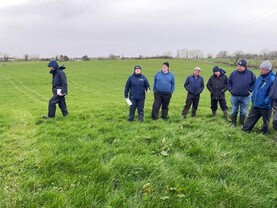Weather issues dominated the discussion at a discussion group meeting in mid-Tipperary last week.
The meeting started under the cover of the cubicle shed on the host farm, but with rain bouncing off the galvanised roof, it was sometimes hard to hear what was being said.
Not enough grass, poor clean-outs, phosphorus deficiency and managing the breeding season were issues discussed and replicated across discussion groups nationally. The following were the key take home messages;
Clean-outs
Poor clean-outs now are probably a result of excess nitrogen in the sward which is making the grass sour. Some farmers were topping after grazing, while others were doing a bit of pre-mowing, all in an attempt to maintain quality for the next round of grazing. It was concluded that growth rates are going to surpass demand over the coming weeks and the best policy is to wait and try take out poorly grazed paddocks for silage in the next rotation.
Pica
About half of the group had experienced phosphorus deficiency over the previous fortnight, with cows seen eating stones, plastic or wire. Most supplemented phosphorus in the water, although some supplied it in the meal.
Some farmers were finding that cows had very brown coats and were wondering if there was an underlying copper deficiency.
Meal
The average level of meal being fed was 2.6kg/cow/day, ranging from 2kg to 4kg/cow/day. Those at the higher end were planning to reduce meal as soon as weather and grass growth improved, although one member was worried about reducing the meal too quickly as the cows were milking over 30l/day.
Breeding
Most members were over three weeks into the breeding season and had over 90% of the herd submitted for AI. The number of cows not yet served and calved over 30 days on farms was small.
In one case, the cows in question got two shots of prostaglandin, but failed to come bulling. The vet then advised the farmer to go in with a fixed time AI programme involving a CIDR or a PRID device.
Getting these cows scanned will speed up the diagnosis and get them back cycling quicker.
Silage
With the cold and wet weather, silage yields are well back on other years and there was a discussion around letting it wait and bulk up or to harvest at in or around the normal time.
The conclusion was that delaying first cut into mid-June reduces silage quality by around 8% DMD and it also reduces the total amount of feed grown on the farm.
This is because aftergrass for grazing or second cut is much slower and later to come back after a very heavy and late first cut.
It was said that during the last fodder crisis in 2018, those that delayed first cut in order to get more bulk were harder hit than those who didn’t. The advice was to take first cut just before or at the same time that it goes to seed.
Glanbia milk restrictions
The final point of discussion was the new Glanbia peak milk restrictions and how to manage over the coming years.
Reducing meal feeding rates, feeding more milk to later-born calves for longer and putting some cows on once-a-day milking were the main solutions put forward to limit members’ exposure to the drastic measures.
Social aspect
There have been very few physical discussion group meetings over the last 18 months and a lot has happened on farms since then.
I’ve been to a few discussion group meetings since the restrictions were lifted and one thing that is common throughout is farmers’ eagerness to talk to each other.
Aside from discussing business, discussion groups have an important role to play as a social outlet. Evening meetings with a barbeque or pizzas should be incorporated into the schedules over the coming months to make up for the missed chats.






 This is a subscriber-only article
This is a subscriber-only article











SHARING OPTIONS: